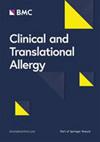Digital Monitoring of Symptoms and Lung Function During Birch Pollen Season in Pediatric Patients
Abstract
Background
Mobile health (mHealth) applications for asthma and allergic rhinitis (AR) may guide patients in following medication use, symptoms, and lung function supporting self-management.
Objective
The primary study objective was to investigate the objective effect of birch pollen on asthma and AR symptoms and medicine use in pediatric patients with varying levels of birch-specific immunoglobulin E (IgE) during the 2022 birch pollen season using digital tools. The secondary objectives were to determine the effect of birch pollen on Asthma Control Test scores, and to record the subjective benefits in self-management while using the application.
Methods
Altogether, 48 pediatric participants were categorized into three groups based on their birch-specific IgE levels. Participants continued their existing asthma control therapy. For allergic rhinitis and conjunctivitis, antihistamines, intranasal corticosteroids (INCS) or a combination of INCS and intranasal antihistamines, and cromoglicates or local antihistamines were prescribed. The study involved daily asthma and allergic rhinitis symptom and medication reporting via the mHealth application (KAMU Health, Finland) combined with microspirometry during the birch pollen season in Helsinki, Finland.
Results
The patients preferred oral AR treatment. However, the low birch pollen levels may have contributed to moderate adherence to AR treatment. A low birch pollen load does not significantly impair lung function in young patients receiving anti-asthmatic treatment regularly. The majority of patients perceived this digital approach as beneficial, irrespective of their level of birch-specific sensitization.
Conclusion
Digital tools support asthma and AR care by enabling disease monitoring, patient engagement, and provide real-world insights for clinicians.


 求助内容:
求助内容: 应助结果提醒方式:
应助结果提醒方式:


